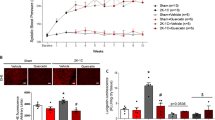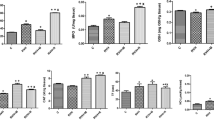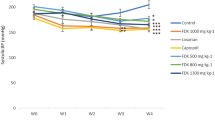Abstract
The aims of the present study were to analyse the effects of an oral daily dose (10 mg/kg) of the dietary flavonoid quercetin for five weeks in two-kidney, one-clip (2K1C) Goldblatt (GB) hypertensive rats. The evolution of systolic blood pressure was followed by weekly measurements, and morphological variables, proteinuria, plasma nitrates plus nitrites (NO x ) and thiobarbituric acid reactive substances (TBARS), liver oxidative stress markers and endothelial function were determined at the end of the experimental period. Quercetin treatment reduced systolic blood pressure of GB rats, producing no effect in control animals. It also reduced cardiac hypertrophy and proteinuria developed in GB hypertensive rats. Decreased endothelium-dependent relaxation to acetylcholine of aortic rings from GB rats was improved by chronic quercetin treatment, as well as increased endothelium-dependent vasoconstrictor response to acetylcholine and overproduction of TXB2 by aortic vessels of GB rats, being without effect in normotensive animals. Increased plasma NO x and TBARS, and decreased liver total glutathione (GSH) levels and glutathione peroxidase (GPX) activity were observed in GB hypertensive rats compared to the control animals. Normalisation of plasma NO x and TBARS concentrations and improvement of the antioxidant defences system in liver accompanied the antihypertensive effect of quercetin. We conclude that chronic oral treatment with quercetin shows both antihypertensive and antioxidant effects in this model of renovascular hypertension. (Mol Cell Biochem 270: 147–155, 2005)
Similar content being viewed by others
References
Textor SC, Wilcox CS: Renal artery stenosis: A common, treatable cause of renal failure? Annu Rev Med 52: 421–442, 2001
Goldblatt H, Lynch J, Hanzal RF, Summerville WW: Studies of experimental hypertension. I. Production of persistent elevation of systolic blood pressure by means of renal ischemia. J Exp Med 59: 347–378, 1934
Lerman LO, Nath KA, Rodriguez-Porcel M, Krier JD, Schwartz RS, Napoli C, Romero JC: Increased oxidative stress in experimental renovascular hypertension. Hypertension 37: 541–546, 2001
Minuz P, Patrignani P, Gaino S, Degan M, Menapace L, Tommasoli R, Seta F, Capone ML, Tacconelli S, Palatresi S, Bencini C, Del Vecchio C, Mansueto G, Arosio E, Santonastaso CL, Lechi A, Morganti A, Patrono C: Increased oxidative stress and platelet activation in patients with hypertension and renovascular disease. Circulation 106: 2800–2805, 2002
Higashi Y, Sasaki S, Nakagawa K, Matsuura H, Oshima T, Chayama K: Endothelial function and oxidative stress in renovascular hypertension. New Engl J Med 346: 1954–1962, 2002
Welch WJ, Mendonca M, Aslam S, Wilcox CS: Roles of oxidative stress and AT1 receptors in renal hemodynamics and oxygenation in the postclipped 2K,1C kidney. Hypertension 41: 692–696, 2003
Braam B, Navar LG, Mitchell KD: Modulation of tubuloglomerular feedback by angiotensin II type 1 receptors during the development of Goldblatt hypertension. Hypertension 25: 1232–1237, 1995
Amiri F, García R: Renal angiotensin II receptor regulation in two-kidney, one clip hypertensive rats: Effect of ACE inhibition. Hypertension 30: 337–344, 1997
Kobayashi S, Ishida A, Moriya H, Mori N, Fukuda T, Takamura T: Angiotensin II receptor blockade limits kidney infury in two-kidney, one-clip Goldblatt hypertensive rats with special reference to phenotypic changes. J Lab Clin Med 133: 134–143, 1999
Hocher B, Godes M, Olivier J, Weil J, Eschenhagen T, Slowinski T, Neumayer HH, Bauer C, Paul M, Pinto YM: Inhibition of left ventricular fibrosis by tranilast in rats with renovascular hypertension. J Hypertens 20: 745–751, 2002
Chade AR, Krier JD, Rodriguez-Porcel M, Breen JF, McKusick MA, Lerman A, Lerman LO: Comparison of acute and chronic antioxidant interventions in experimental renovascular disease. Am J Physiol Renal Physiol 286: F1079–F1086, 2004
Rodriguez-Porcel M, Herrman J, Chade AR, Krier JD, Breen JF, Lerman A, Lerman LO: Long-term antioxidant intervention improves myocardial microvascular function in experimental hypertension. Hypertension 43: 493–498, 2004
Duarte J, Pérez-Palencia R, Vargas F, Ocete MA, Pérez-Vizcaino F, Zarzuelo A, Tamargo J: Antihypertensive effects of the flavonoid quercetin in spontaneously hypertensive rats. Br J Pharmacol 133: 117–124, 2001
Duarte J, Galisteo M, Ocete MA, Pérez-Vizcaíno F, Zarzuelo A, Tamargo J: Effects of chronic quercetin treatment on hepatic oxidative status of spontaneously hypertensive rats. Mol Cell Biochem 221: 155–160, 2001
Duarte J, Jiménez R, O’Valle F, Galisteo M, Pérez-Palencia R, Vargas F, Pérez-Vizcaíno F, Zarzuelo A, Tamargo J: Protective effects of the flavonoid quercetin in chronic nitric oxide deficient rats. J Hypertens 20: 1843–1854, 2002
Bradford MM: A rapid and sensitive method for the quantitation of microgram quantities of protein utilizing the principle of protein-dye binding. Anal Biochem 72: 248–254, 1976
Anderson ME: Determination of glutathione and glutathione disulfide in biological samples. Methods Enzymol 113: 548–555, 1985
Jiménez R, Andriambeloson E, Duarte J, Andriantsitohaina R, Jiménez J, Pérez-Vizcaino F, Zarzuelo A, Tamargo J: Involvement of thromboxane A2 in the endothelium-dependent contractions induced by myricetin in rat isolated aorta. Br J Pharmacol 127: 1539–1544, 1999
Wille PR, Ribeiro-do-Valle RM, Simoes CM, Gabilan NH, Nicolau M: Effect of quercetin on tachykinin-induced plasma extravasation in rat urinary bladder. Phytother Res 15: 444–446, 2001
Cyrino LA, Cardoso RC, Hackl LP, Nicolau M: Effect of quercetin on plasma extravasation in rat CNS and duramater by ACE and NEP inhibition. Phytother Res 16: 545–549, 2002
Galisteo M, García-Saura MF, Jiménez R, Villar IC, Wangensteen R, Zarzuelo A, Vargas F, Duarte J: Effects of quercetin treatment on vascular function in deoxycorticosterone acetate-salt hypertensive rats. Comparative study with verapamil. Planta Med 2004
Galisteo M, García-Saura MF, Jimenez R, Villar IC, Zarzuelo A, Vargas F, Duarte J: Effects of chronic quercetin treatment on antioxidant defence system and oxidative status of deoxycorticosterone acetate-salt-hypertensive rats. Mol Cell Biochem 259: 91–99, 2004
Aoi W, Niisato N, Miyazaki H, Marunaka Y: Flavonoid-induced reduction of ENaC expression in the kidney of Dahl salt-sensitive hypertensive rat. Biochem Biophys Res Commun 315: 892–896, 2004
Gavras H, Brunner HR, Larga JH, Vaughan ED Jr, Koss M, Cote LJ, Gavras I: Malignant hypertension resulting from deoxycorticosterone acetate and salt excess: Role of renin and sodium in vascular changes. Circ Res 36: 300–309, 1975
Weinberger MH: Sodium sensitivity of blood pressure. Curr Opin Nephrol Hypertens 2: 935–939, 1993
Alcocer F, Whitley D, Salazar-Gonzalez JF, Jordan WD, Sellers MT, Eckhoff DE, Suzuki K, Macrae C, Bland KI: Quercetin inhibits human vascular smooth muscle cell proliferation and migration. Surgery 131: 198–204, 2002
Yoshizumi M, Tsuchiya K, Suzaki Y, Kirima K, Kyaw M, Moon JH, Terao J, Tamaki T: Quercetin glucuronide prevents VSMC hypertrophy by angiotensin II via the inhibition of JNK and AP-1 signaling pathway. Biochem Biophys Res Commun 293: 1458–1465, 2002
Moon SK, Cho GO, Jung SY, Gal SW, Kwon TK, Lee YC, Madamanchi NR, Kim CH: Quercetin exerts multiple inhibitory effects on vascular smooth muscle cells: Role of ERK1/2, cell-cycle regulation, and matrix metalloproteinase-9. Biochem Biophys Res Commun 301: 1069–1078, 2003
Qin TC, Chen L, Yu LX, Gu ZL: Inhibitory effect of quercetin on cultured neonatal rat cardiomyocytes hypertrophy induced by angiotensin. Acta Pharmacol Sin 22: 1103–1106, 2001
Wang C, Wang HY, Yuan ZK, Zhao XN, Wang X, Zhang ZX: Quercetin decreased heart rate and cardiomyocyte Ca2+ oscillation frequency in rats and prevented cardiac hypertrophy in mice. Zhongguo Yao Li Xue Bao 20: 426–430, 1999
Ortenberg JM, Cook AK, Inscho EW, Carmines PK: Attenuated afferent arteriolar response to acetylcholine in hypertension. Hypertension 19: 785–789, 1992
Bennett MA, Thurston H: Effect of angiotensin-converting enzyme inhibitors on resistance artery structure and endothelium-dependent relaxation in two-kidney, one-clip Goldblatt hypertensive and sham-operated rats. Clin Sci (London) 90: 21–29, 1996
Peach MJ, Loeb AL: Changes in vascular endothelium and its function in systemic arterial hypertension. Am J Cardiol 60: 110I–115I, 1987
Nava E, Farre AL, Moreno C, Casado S, Moreau P, Cosentino F, Luscher TF: Alterations to the nitric oxide patway in the spontaneously hypertensive rat. J Hypertens 16: 609–615, 1998
Wu CC, Yen MH: Higher level of plasma nitric oxide in spontaneously hypertensive rats. Am J Hypertens 12: 476–482, 1999
Hong KJ, Loh SH, Yen MH: Suppression of the development of hypertension by the inhibitor of inducible nitric oxide synthase. Br J Pharmacol 131: 631–637, 2000
Adcock IM, Brown CR, Kwon O, Barnes PJ: Oxidative stress induces NFκB DNA binding and inducible NOS mRNA in human epithelial cells. Biochem Biophys Res Commun 199: 1518–1524, 1994
López-López G, Moreno L, Cogolludo A, Galisteo M, Ibarra M, Duarte J, Lodi F, Tamargo J, Perez-Vizcaino F: Nitric oxide (NO) scavenging and NO protecting effects of quercetin and their biological significance in vascular smooth muscle. Mol Pharmacol 65: 851–859, 2004
Yuan YV, Kitts DD, Godin DV: Variations in dietary fat and cholesterol intakes modify antioxidant status of SHR and WKY rats. J Nutr 128: 1620–1630, 1998
Galati G, Moridani MY, Chan TS, O’Brien PJ: Peroxidative metabolism of apigenin and naringenin versus luteolin and quercetin: Glutathione oxidation and conjugation. Free Radic Biol Med 30: 370–382, 2001
Selloum L, Reichl S, Müller M, Sebihi L, Arnhold J: Effects of flavonols on the generation of superoxide anion radicals by xanthine oxidase and stimulated neutrophils. Arch Biochem Biophys 395: 49–56, 2001
Hanasaki Y, Ogawa S, Fukui S: The correlation between active oxygen scavenging and antioxidative effects of flavonoids. Free Radical Biol Med 16: 845–850, 1994
Manach C, Morand C, Crespy V, Demigné C, Texier O, Régérat F, Rémésy C: Quercetin is recovered in human plasma as conjugated derivatives which retain antioxidant properties. FEBS Lett 426: 331–336, 1998
Carvalho MH, Fortes ZB, Nigro D, Oliveira MA, Scivoletto R: The role of thromboxane A2 in the altered microvascular reactivity in two-kidney, one-clip hypertension. Endothelium 5: 167–178, 1997
Himmelstein SI, Klotman PE: The role of thromboxane in two-kidney, one-clip Goldblatt hypertension in rats. Am J Physiol 257: F190–F196, 1989
Boussairi EH, Sacquet J, Sassard J, Benzoni D: Thromboxane A2-prostaglandin H2 and renovascular hypertension in rats. Am J Physiol 267: R1190–R1197, 1994
Wilcox CS, Cardozo J, Welch WJ: AT1 and TxA2/PGH2 receptors maintain hypertension throughout 2K, 1C Goldblatt hypertension in the rat. Am J Physiol 271: R891–R896, 1996
Author information
Authors and Affiliations
Corresponding author
Additional information
M.F. García-Saura and M. Galisteo are equal contributors to this work
Rights and permissions
About this article
Cite this article
García-Saura, M.F., Galisteo, M., Villar, I.C. et al. Effects of chronic quercetin treatment in experimental renovascular hypertension. Mol Cell Biochem 270, 147–155 (2005). https://doi.org/10.1007/s11010-005-4503-0
Received:
Accepted:
Issue Date:
DOI: https://doi.org/10.1007/s11010-005-4503-0




